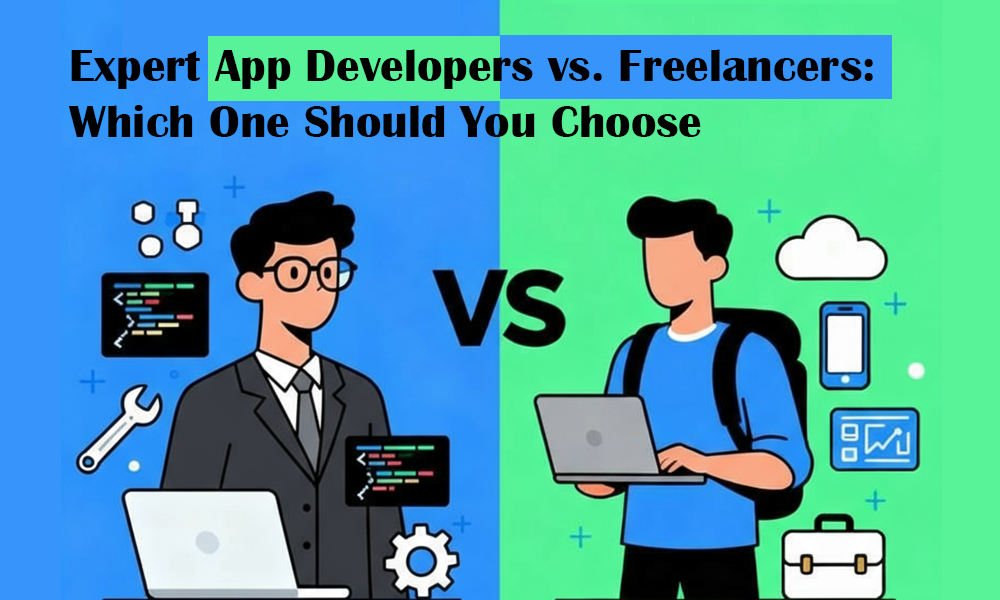You’ve struck gold with your business. Your customer base has quadrupled in a short span, and now you really need a robust and functional mobile app that can handle a gargantuan amount of traffic without going kaput midway, leaving you and your customers in the doldrums. So, where do you go with your requirement? Do you just hire freelancers from Upwork or Fiverr with the lowest rates and hope everything works well? Or do you do some soul searching and decide to go with expert app developers from a major remote staffing solutions provider like us?
It’s a conundrum that has weighed heavily on many an entrepreneur, especially those standing at the cusp of much-awaited success. Thankfully, you’re here, reading this blog right now, and we’ll do our best to cut the clutter and dispel myths. So, grab your prescription glasses and dive into this blog.
1. What’s Your Requirement, Again?
Let’s go back a few steps to where we started. So, you need a mobile app for your business that:
- Loads fast
- Looks good
- Scales like crazy
- And doesn’t leak user data
- Oh, and it’s stable as hell
- And then you want it ready like…yesterday
Tall ask! But one needs what one needs! Want to hear how your “requirement” sounds in the technical parlance? Here goes:
- Optimized Backend APIs (REST/GraphQL) for low-latency data transfer.
- Content Delivery Network (CDN) integration for faster static asset delivery.
- Responsive UI/UX Frameworks (React Native, Flutter) for cross-platform consistency and speed.
- Microservices Architecture for modular development and horizontal scalability.
- Auto-scaling Infrastructure (AWS, GCP, Kubernetes) to handle traffic surges effortlessly.
- End-to-End Encryption (TLS/SSL, AES) to secure data in transit and at rest.
- Role-Based Access Control (RBAC) and OAuth2 for secure user authentication and permissions.
- Continuous Integration/Continuous Deployment (CI/CD) pipelines for rapid, error-free rollouts.
- Real-Time Crash Monitoring (Firebase Crashlytics, Sentry) to catch and fix issues instantly.
- Automated Testing (Unit, Integration, End-to-End) to ensure stability before every deployment.
Whoever told you all this was easy-peasy stuff was kidding. The scale of the task and timeline make it a hardcore professional’s domain – something we aren’t sure a freelancer can handle; something we are sure requires you to hire a mobile app developer.
2. The Myth of The Freelancing Genius – Does It Hold Up?

Disclaimer: We have nothing against freelancers and acknowledge the fact that all the digital marvels we admire now have their origins in the modest workshops of lone wolf geniuses. The myth of the freelancer with God-level talent isn’t going away anytime soon. And any freelancer worth their salt will probably handle your project like a man on a mission, unless, of course, they have commitments to keep with 16 other clients simultaneously. Ahem!
Something that tends to be ignored is that trusting a freelancer blindly with the development of a mission-critical app is kind of iffy. They might have the credentials to fix your Bugatti, but not an airplane, which, by the way, is what your app must be. And the reason is simple: mobile apps are very complicated these days and require a lot of pre-launch and post-launch work to function perfectly.
Sure, you’ll save some money upfront by hiring freelancers and gig workers. You’ll probably have the first prototype ready on time. But then, somewhere between testing and deployment, things might start to unravel. And if and when that happens, chaos will ensue. No critical bug fixing. Zero scalability. Ghosting. Elevated heart rate. A nightmare in the making!
3. Full-time App Developer vs. Freelancer
There are many talented freelancers out there who have received heaps of praise from their clients. They are committed. They are diligent. And they deliver on time. But when we talk about expert app developers, we aren’t referring to driven individuals. We are talking about entire development teams in this context – teams that have built apps across the board. Healthcare, Fintech, Ecom, Social Media – you name it. These hardened professionals have seen it all – bad code, no code, seemingly unfixable bugs – and they have triumphed.
Besides, when you hire mobile app developers from remote staffing solutions providers, you aren’t communicating with professionals working in silos. You are taking delivery of a well-oiled and regulated machinery comprising Project Managers, QA testers, UI/UX Designers, DevOps engineers – basically the whole arsenal of app development firepower.
And these people are genuinely good at what they do. They anticipate OS updates, device compatibility issues, API failures, and edge-case user behaviors that would make a gig worker’s head spin. And they do all this while keeping delivery timelines and budgets in check. For all practical purposes, the one-man-army approach begins to look rickety in the face of complex projects.
4. The Dark Economics of Cheap Development
The biggest reason people want to go with freelancers is money, and one can’t be blamed for it. Saving money is one way of ensuring profitability for sure. But one cannot be myopic when it comes to building a brand. Upfront savings can be just as easily offset by post-development fixes.

Bad architecture means technical debt. Rushed QA means post-launch bugs. Lack of documentation means every future developer you hire will bill you double just to untangle the spaghetti. And then there’s the ever-looming fear of communications breakdown. Don’t get it? Let us explain it to you.
Go to LinkedIn or Reddit and search for threads on “Freelancer ghosted me.” It’s like wandering into a digital trauma support group. But there’s a reason why this happens so often. Freelancers have to juggle multiple projects at once. Reason? Their livelihood depends on it. Everyone’s got to pay their bills, right? So, if you’re not paying top dollar or giving them 40+ hours a week, you’re just another client on their calendar. This leads to radio silence. Missed deadlines. Unread emails. Slack channels filled with tumbleweed.
However, remote staffing solutions providers price their work based on process, documentation, QC, and post-launch support. That last bit – post-launch support – is paramount in the app development domain. As the one commissioning the app, you need a helping hand in case things begin to go south post launch.
In the end, when you hire mobile app developers from remote staffing solutions providers like ourselves, you are essentially paying for peace of mind. Why should entrepreneurship be a headache and not an adrenaline-filled joyride?
5. Scaling with Confidence
So, your mobile app’s ready. Version 1 has been widely regarded as a successful initiative. But your customer base is growing like a tidal wave, and you need a new and improved version pretty soon. Else, it’ll be Titanic redux for you. Ominous, eh? But you had your app made by a freelancer, and he never architected your app for scale. Load testing, caching strategies, microservices, API throttling, continuous deployment pipelines – he probably didn’t describe these to you as well.
You know what? To expert app developers working full-time for you, it’s important that you – the client – know your mobile app inside out. Their philosophy is: “Minimum Viable Product” isn’t “Minimum Possible Effort.” It’s laying the groundwork for future updates, traffic spikes, and feature rollouts. So, they implement CI/CD pipelines, write modular, maintainable code, and help you move seamlessly from 1,000 users to 100,000 without the whole system collapsing like a Jenga tower in an earthquake.
6. So, Which One Should You Choose?
If you’re building a quick proof of concept or a throwaway MVP you’ll abandon next month, sure, roll the dice. Hire a freelancer.
But…
- If you’re serious about your app;
- If you want real users, real revenue, and real scalability;
- If you want developers who show up on time, write clean code, fix bugs, document features, and future-proof your product;
Then don’t kid yourself.
Hire mobile app developers from a reliable remote staffing solution provider. You’ll sleep and your app will actually work, which, after all, was the point!




